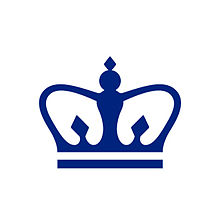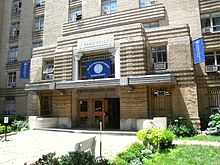- Columbia University College of Physicians and Surgeons
-
Columbia University College of Physicians and Surgeons 
Established 1767 Type Private Endowment US$1.136 Billion [1] Dean Lee Goldman, M.D. Academic staff 4,300 Students 1,520
606 M.D.
94 M.D./Ph.D.
776 Ph.D.Location Manhattan, New York, USA Campus Urban Columbia University College of Physicians and Surgeons, often known as P&S, is a graduate school of Columbia University that is located on the health sciences campus (Columbia University Medical Center) in the Washington Heights neighborhood of Manhattan. Founded in 1767 as the medical department of King's College (now Columbia University), the College of Physicians and Surgeons was the first medical school in the thirteen colonies and hence, the United States, to award the Doctor of Medicine (M.D.) degree. Beginning in 1993, P&S also was the first medical school in the United States to hold a White Coat Ceremony.[2]
According to U.S. News and World Report P&S is one of the most selective medical schools in the United States based on average MCAT, GPA, and acceptance rate. In 2010, 6,227 people applied and 1,253 were interviewed for 166 positions in its entering class. The average undergraduate GPA and average MCAT score for successful applicants in 2010 were 3.78 and 35.7, respectively. Columbia currently is ranked tenth amongst research-oriented medical schools in the United States by U.S. News and World Report. It is affiliated with New York-Presbyterian Hospital, the nation's sixth-ranked hospital according to U.S. News and World Report.
Contents
Curriculum
Beginning in the fall of 2009, the medical school implemented a new curriculum that differed markedly from more traditional structures. The largest change involved a reduction in the number of preclinical months from twenty-four to eighteen and the expansion of the electives and selectives period to fourteen months. Each student now is required to spend four months working on a scholarly project during the third year before graduation.[3]
Student life
Campus
Situated on land overlooking the Hudson River and separated from Columbia's undergraduate campus in Morningside Heights by approximately fifty blocks and the neighborhood of Harlem, the Columbia University Medical Center has its own unique standing and identity. The campus comprises not only P&S, but also the College of Dental Medicine (formerly the School of Dental and Oral Surgery), the School of Nursing, the Mailman School of Public Health, the Presbyterian portion of New York-Presbyterian Hospital (including the Morgan Stanley Children's Hospital) and the New York State Psychiatric Institute. Affiliated hospitals include St. Luke's-Roosevelt Hospital Center, Harlem Hospital, Stamford Hospital in Stamford, Connecticut and Bassett Hospital in Cooperstown, New York.
Housing options on Columbia's Medical Campus include Bard Hall and the Bard-Haven Towers, a complex of three, 31-story apartment buildings overlooking the Hudson River and the George Washington Bridge. First year students are guaranteed housing on campus, although many first year students choose to live in other parts of New York City.
P&S Club
P&S is notable amongst U.S. medical schools for its devotion to a diversely-talented student body, including world-class musicians, Olympic athletes, and chess masters. There are a host of student clubs available at P&S that cover a range of interests, both professional and personal; all of which fall under the umbrella of the P&S Club. One unusual element is the Bard Hall Players, a theatrical group entirely run by the students of the medical campus, and one of the largest and most active medical school theater groups in the country. They perform a musical and two plays each year. Founded over a century ago by John Mott, the 1946 Nobel Peace Prize recipient, the P&S Club serves to support and provide activities and organizations for the enrichment of the lives of P&S students. The P&S Club is well known for its humanitarian aims; most notably the 1917 purchase of a steam launch delivered to Sir William Grenfell, a physician living in Labrador. This launch was used to deliver medical services to the Eskimo and Native American fishermen living on the islands of the Labrador coast and frequently, was manned by P&S students.
History
Colonial Years
In 1767, King's College (now Columbia University) opened a medical school. At the time, the medical program at King's College was the first to open in the Province of New York and only the second to be opened in the American Colonies. Three years later, in 1770, King's College conferred its first medical degree to Robert Tucker, this would prove to be the first Doctor of Medicine awarded in the Thirteen Colonies. Prior to King's College of Medicine offering of the M.D. degree, other American and Canadian medical schools had been offering the M.B. degree. King's College continued to educate young doctors until 1776, when the school was forced to close due to the onset of the Revolutionary War and the occupation of New York by British soldiers. King's College remained closed until 1784 when the school was reopened as Columbia College and in December of that year the faculty of the medical school were re-instated. In 1791 Dr. Samuel Bard, a prominent colonial physician whom George Washington credited with saving his life, was named dean of the medical school.
Merger with the College of Physicians and Surgeons
In 1807, with a growing young nation in need of adequately trained phyicians, the New York State Board of Regents founded, under separate charter, the College of Physicians and Surgeons. Merely four years later, in 1811, Dr. Samuel Bard, dean of Columbia University Medical School, became president of the College. The year 1814 then saw the merger of Columbia University Medical School into the College of Physicians and Surgeons, a move that was made in an attempt to reverse what then was perceived as a period of decline for the medical school. Despite this merger, the College of Physicians and Surgeons retained its independence from Columbia and it was only in 1860 that the College of Physicians and Surgeons, at that time occupying buildings across West Fifty-ninth Street from the Roosevelt Hospital (its major teaching hospital at the time), after severing its ties to the New York Board of Regents and through agreement between the trustees of the College of Physicians and Surgeons and Columbia, became the official medical school of Columbia University. This new relationship between the college and Columbia was minimal at best, however, with the college retaining independence from Columbia. It was not until 1891 that the College of Physicians and Surgeons would be fully integrated and incorporated into Columbia. In 1886, the Sloane Maternity Hospital, later the Sloane Hospital for Women, was founded as part of Physicians and Surgeons.
Medical Center Formation
In 1911, Columbia University entered into a "Formal Agreement of Alliance" with Presbyterian Hospital, a hospital founded in 1868 by James Lenox a New York philanthropist. It was this alliance that helped to pave the way for the creation of a new medical center format. In 1928, the Columbia-Presbyterian Medical Center opened its doors. Set on land in the Washington Heights section of Manhattan, Columbia-Presbyterian Medical Center was the first place in the world to provide facilities for patient care, medical education, and research all under one roof. It was the first academic medical center and pioneered the practice of combining medical training with patient care. Included in this project with Presbyterian Hospital were the Babies Hospital, the Neurologic Institute of New York, and the New York State Psychiatric Institute; these were then joined in 1950 by the New York Orthopaedic Hospital.
In 1997, the Presbyterian Hospital merged with New York Hospital (partner of Weill Cornell Medical College of Cornell University) to form the New York-Presbyterian Hospital. This new hospital system also has incorporated many of the satellite hospitals and affiliated programs of these two institutions. While the two medical schools remain independent of one another, there has been significant cross-fertilization between the two campuses, leading to increasing numbers of shared research experiences and training programs. NYPH is now the largest private employer in New York City. All hospitals in the New York-Presbyterian Healthcare System are affiliated with either the Cornell or Columbia medical schools.
Prominent faculty
Prominent faculty members include Nobel Prize laureates Richard Axel and Eric Kandel; cardiothoracic surgeon, author, talk show host, and commentator Mehmet Oz; author Oliver Sacks; and 2011 Pulitzer Prize winner for nonfiction Siddhartha Mukherjee.
Notable P&S Alumni
Main category: Columbia Medical School alumniPopular and notable medical innovators
- Virginia Apgar (Apgar score)
- Oswald Avery (pioneer in immunochemistry)
- T. Romeyn Beck (pioneer in medical jurisprudence)
- Thomas Berry Brazelton (pediatrician, Brazelton Neonatal Behavioral Assessment Scale)
- Charles Drew (ground-breaking work in blood transfusions, blood storage, large-scale blood banks)
- Tom Frieden (Director of U.S. Centers for Disease Control and Prevention (CDC), New York City Health Commissioner)
- William Halsted (introduced several new operations, one of the "Big Four" founding professors at Johns Hopkins Hospital)
- Jean Emily Henley (wrote the first widely used anesthesia textbook)
- Robert Lefkowitz (U.S. National Medal of Science and Shaw Prize)
- Sean E. McCance (orthopedic surgeon)
- David McDowell (psychiatrist, author, consultant)
- Benjamin Spock (pediatrician, wrote Baby and Child Care)
- Paul Stelzer (cardiothoracic surgeon)
- P. Roy Vagelos (president, CEO, chairman of pharmaceutical company Merck)
- William H. Welch (one of the "Big Four" founding professors at Johns Hopkins Hospital)
- Allen Whipple (Whipple procedure, Whipple's triad)
Nobel Prize laureates
- Baruch Samuel Blumberg
- Joshua Lederberg
- Dickinson W. Richards
- Harold Varmus (Director of the National Institutes of Health, President of Memorial Sloan-Kettering Cancer Center)
Writers
- Jacob Appel
- Robert Coles (Pulitzer Prize for General Non-Fiction, MacArthur Award "genius grant", Presidential Medal of Freedom, National Humanities Medal)
- Robin Cook (100 million+ copies of works in print)
- Jerome Groopman
- Walker Percy
- John E. Sarno (originator of the diagnosis of psychosomatic condition, tension myositis syndrome)
Others
Others alumni include astronaut Story Musgrave, Olympic champion Jenny Thompson (twelve medals, including eight gold medals), and former Afghan prime minister Abdul Zahir.
Serb politician Radovan Karadžić studied at Columbia for a year. Former NBA player Mark Pope attended P&S, but left to coach college basketball.
In fiction
Characters Derek Shepherd, Mark Sloan, Teddy Altman, and Addison Montgomery from television's Grey's Anatomy, along with spin off series Private Practice, Sam Bennett, and Naomi Bennett, all were portrayed as graduates of Columbia University College of Physicians and Surgeons. Rob Morrow, "Joel Fleischman" from television's Northern Exposure, attended medical school at Columbia.
References
External links
Columbia University Academics College · Engineering · General Studies · Architecture · Arts · Arts & Sciences · Business · Continuing Education · Dental · Engineering · Journalism · Law · Medicine · Nursing · Public Affairs · Public Health · Social Work · Barnard (affiliate) · JTS (affiliate) · Teachers College · UTS (affiliate) · The School (K-12 affiliate)
Institutes and research centers Athletics Campus Student life People
Categories:- Columbia University
- Schools of medicine in New York
- Washington Heights, Manhattan
Wikimedia Foundation. 2010.


